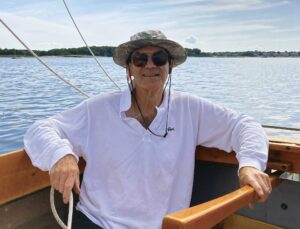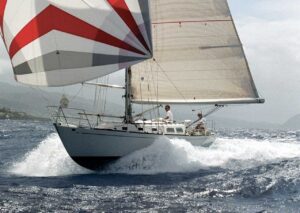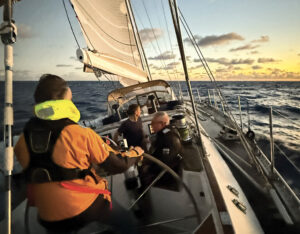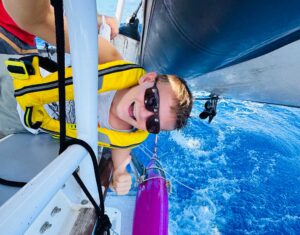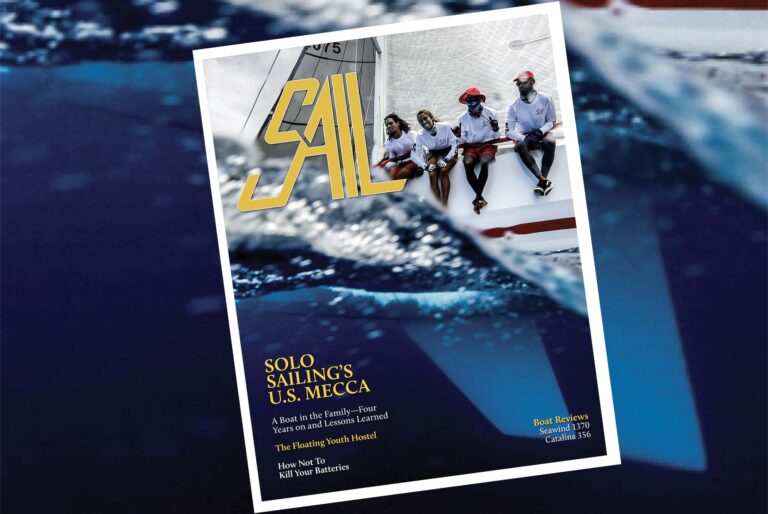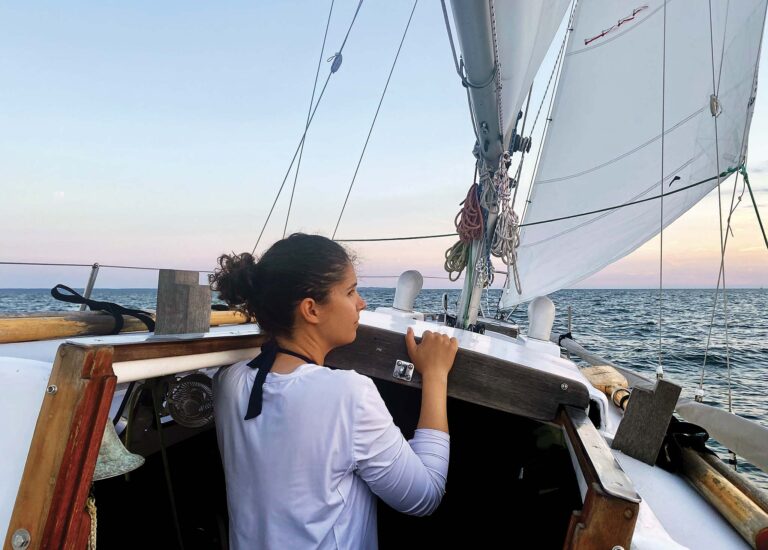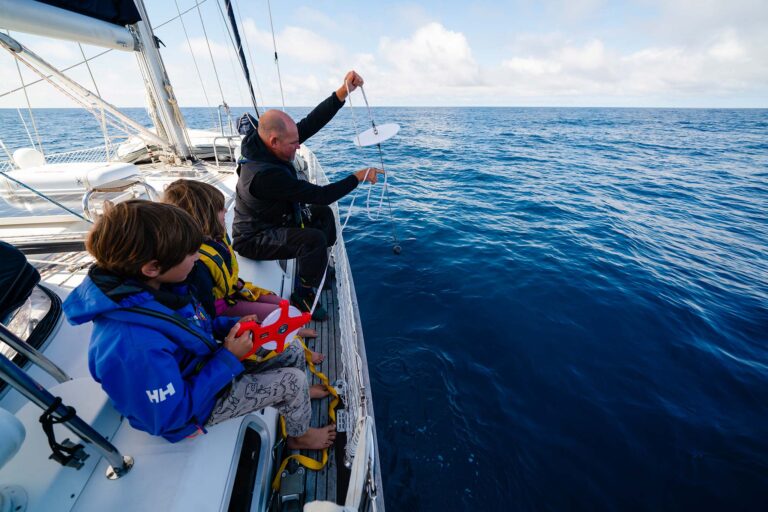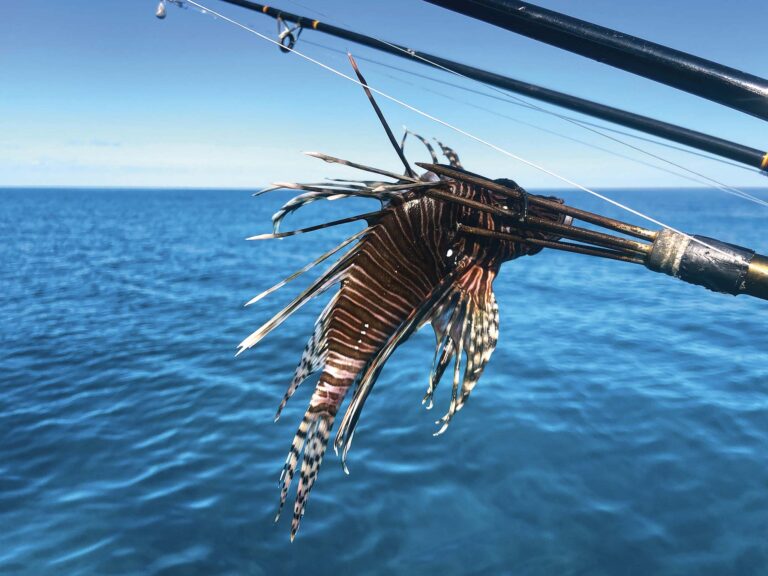
The Cruising Club of America, an organization of about 1,300 offshore sailors, has been honoring remarkable ocean voyages and seamanship with an array of prestigious awards for nearly 100 years. The club’s highest honor, the Blue Water Medal, has recognized renowned and little-known sailors alike, from Sir Robin Knox-Johnston to the British mariners who rescued untold thousands of Allied troops from the beaches of Dunkirk in 1940.
The CCA also gives an award for acts of exceptional seamanship and rescue, and most recently (in 2016) established what it calls its Young Voyager Award, recognizing “a young sailor who has made one or more exceptional voyages.” The inaugural awardee was polar voyager Erik de Jong. Subsequent awards have gone to solo nonstop circumnavigator Jessica Watson, my husband, Seth, and me, and round-the-Americas solo-sailor Guirec Soudée.
This year’s awardees are a pair of adventuresome yet modest French sailors, Adrien Kollar and Calypso Romero. Still, in their early 30s, the couple has already made several exceptional voyages, taking in challenging high-latitude waters and places seldom visited by bluewater sailors. They are also remarkably resourceful, a quality much in evidence when they were dismasted in the Indian Ocean, and refreshingly humble, interested in sailing and adventure for its own sake rather than publicity or outside validation. They have no blog, no public social media, no YouTube channel. In fact, it was difficult for them even to find photographs to provide for the CCA’s Awards slideshow or this article. Despite their youth, Adrien and Calypso seem like something of a throwback to an earlier time of exploration and adventure undertaken purely for the experience of it.
Adventuresome Childhoods
Calypso has been a sailor since infancy, growing up aboard her parents’ 26ft gaff-rigged wooden cutter. Born in a small town in Australia’s Northern Territory, Calypso was brought aboard the family’s floating home only four days later. Another few years after that, on the French Indian Ocean island of Reunion, her parents built another, bigger boat, a 40ft cold-molded wooden gaff-rigger. Sailing by way of South Africa and Panama, the family reached New Caledonia, a French territory in the western South Pacific, by the time Calypso was 16. There she began sailing aboard more modern boats and taking part in racing.
Adrien also had an adventuresome childhood. Growing up between Senegal and France, he was keenly interested in mechanics and motorsports. Then he discovered the sea at the age of 20, when he and his father purchased a 34ft sloop and voyaged together for three years from France to New Caledonia via the Caribbean, Panama and the islands of the South Pacific. He’s been hooked on sailing and the sea ever since.
The couple began voyaging together in 2012 after meeting in a captain’s certification course in New Caledonia. Soon afterward, they set off from New Zealand aboard a retired Open 50 racer owned by a friend of Adrien’s who wanted it delivered back home to France. Better still, the owner wasn’t in any hurry, which meant Calypso and Adrien were able to visit a number of places off the beaten track along the way, including the Solomon Islands, Sri Lanka and the Maldives. Unfortunately, the yacht was not in good shape, and the couple’s voyage soon turned even more adventurous than expected when, while sailing from the Maldives to the Mascarene Islands, they lost the yacht’s 70ft mast.
“The step of the mast on deck was peeled off,” Calypso says. “The mast fell off with a noisy ‘crack’ and ended up on the starboard side with its carbon fiber laminate roots in the air.” Despite the light wind, a big swell was running, and the mast broke into three pieces when it hit the starboard bilge keel. The pieces of mast then began punching into the hull, making it imperative Calypso and Adrien them free as quickly as possible to prevent further damage to the hull.
Two hours later, after saving the boom, staysail and as many lines as they could, Calypso reports matter-of-factly: “We were making way again downwind, with a windsurf mast fixed in the windlass and the storm jib [hoisted] upside down.” They also altered course and headed for the British Indian Ocean Territory of Chagos, 300 nautical miles downwind, which they reached five days later. Granted permission to enter the territory to effect a better jury rig, they were soon setting off again, this time with three little masts made of the yacht’s 21ft spinnaker pole and a pair of Hobie Cat masts with sails cut out of a large genoa. It’s a testament to the couple’s resourcefulness that they constructed this jury rig in just three days.
After that, the lightweight Open 50 made between 3 and 5 knots with this rig throughout the nearly 1,000-mile passage to Rodrigues, an island surrounded by shallow coral reefs where Adrien and Calypso hoped to find a wreck with a mast they could salvage as a more permanent replacement. Unsuccessful in their search, they continued on under jury rig to Mauritius, Reunion Island and then Mayotte, a French territory in the Mozambique Channel between Madagascar and Africa. In all, they sailed an incredible 2,400 miles under jury rig.

A Salvaged Mast
On Mayotte, Adrien and Calypso found both a 50ft-tall mast to salvage and jobs for the following 10 months. Then in June 2014, they were underway again, calling in at Tanzania, Madagascar and the Comoros Islands before rounding the Cape of Good Hope. Crossing the Atlantic from southeast to northwest, they called at the British islands of St. Helena and Ascension and the Brazilian islands of Fernando de Noronha before reaching South America in French Guiana. They completed the voyage to France via the Caribbean, Azores and Gibraltar.
While in French Guiana, they’d made a deal with the owner of two dilapidated sailboats to refit the larger one in exchange for keeping the smaller. They were ultimately able to sell the smaller one, giving them the means to buy a 37ft Jeanneau ketch, which they named Jalan. Thus it was that in 2016 they set sail from France aboard their own boat, bound for Tierra del Fuego via the Canary Islands, Cape Verde Islands and Argentina.
As they got farther south, they found their ketch was ill-prepared for the cold, having little insulation, an inefficient heater and no means of receiving weather forecasts. So when they were offered the chance to voyage to Antarctica aboard two better-equipped boats in Ushuaia, they jumped at it. As there was only room for one of them on each boat, Adrien sailed aboard a friend’s 40ft aluminum sloop and Calypso aboard a 70ft aluminum charter yacht. “It was an amazing voyage to a magic world, where I had never thought to go to,” Calypso says of the experience.
Across the Pacific to Antarctica
Upon their return to Ushuaia, they reunited with Jalan and sailed north Patagonia. “It took us two months to get to Chiloe Island,” Calypso says, “all sailing against the wind, saving the old engine. It was tough. We had to tack every 15 minutes. Every evening, though, we could stop in a nice anchorage in the many caletas (small bays)along the way.”
By 2018, Adrien and Calypso were sailing across the Pacific from Valdivia, Chile, to Juan Fernandez, Easter Island and French Polynesia. As they were doing so, they were offered jobs aboard Spirit of Sydney, a 60ft aluminum former BOC Challenge yacht converted for chartering in Antarctica. They worked as captain (Calypso) and first mate (Adrien) aboard her in the southern summers of 2018 and 2019, taking passengers to see the glaciated beauty of the Antarctic Peninsula.
Before the 2019 charter season, they sold Jalan in Tahiti, planning to purchase a larger boat in France. However, the pandemic hit following their return at the end of the year’s Antarctic charter season, and they found themselves locked down. They used their time in isolation to check out countless online yacht listings and in May 2020 found Keanui, a 50ft aluminum yacht that had been abandoned for many years. Adrien and Calypso refitted the boat entirely by themselves, converting the flush deck to a cabin with coachroof, building a sugar scoop on the transom, and installing solar panels and a wind generator. Calypso says they still have a lot of work to do on the interior, but “We already live on board and she sails nicely! We are looking forward to going back to the Pacific and sailing to remote places.” True to her word, at press time, she and Adrien had already made their way to Las Palmas, in the Canary Islands, their love of sailing and the sea still not even close to being sated.
Ed Note: For more on this year’s Cruising Club of America awards, including the Blue Water Medal, Far Horizon’s Medal and its recognition of the Salty Dawg Sailing Association for the help the association rendered in the early days of the pandemic, visit cruisingclub.org
April 2021




